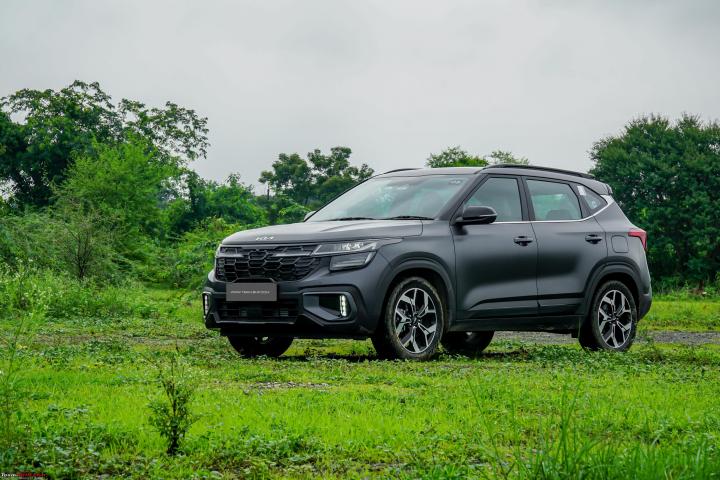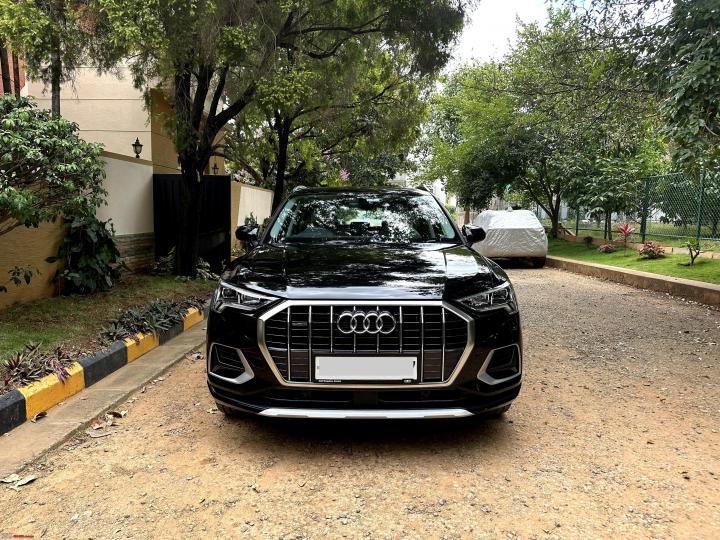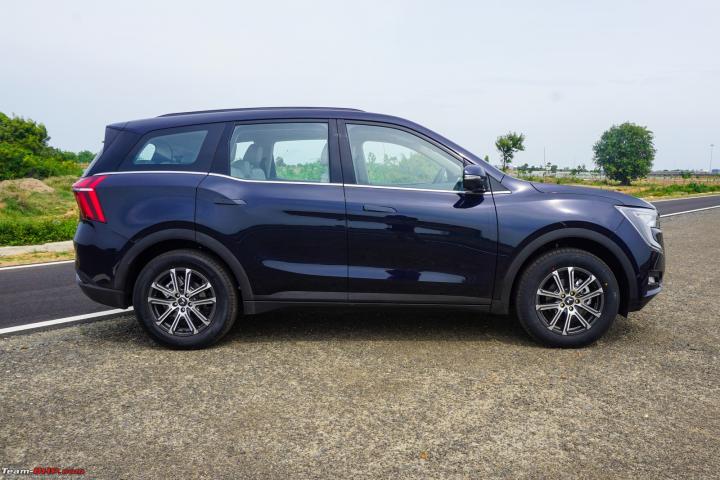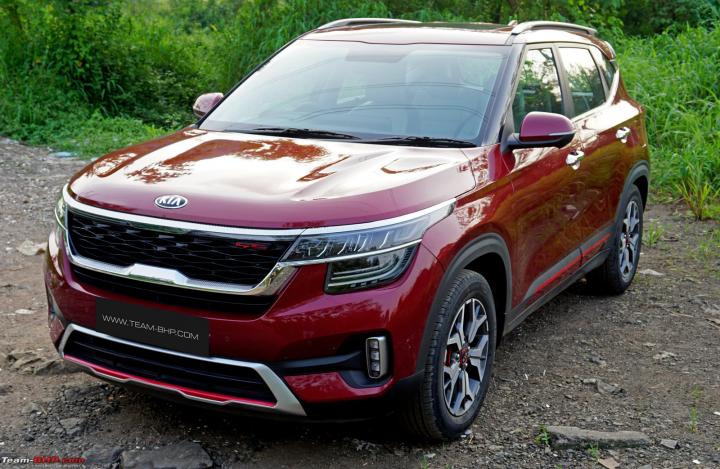News
Testing Carlinkit wireless adapter worth Rs 6,200 in my Seltos & XUV700
Setup is pretty easy. Like connecting to Android Auto or Apple CarPlay wireless on my XUV700
BHPian wadewilson recently shared this with other enthusiasts.
Bought the Carlinkit Wireless Dongle during an Amazon sale for Rs. 6200. A few observations:
- The setup is pretty easy. Like connecting to Android Auto or Apple CarPlay wireless on my XUV700, we just need to connect to the Carlinkit dongle which acts as an interface between the car and our phones and that's it. The next time you start your car, the phone will automatically connect to Android Auto or Apple CarPlay.
- Due to the force of habit of using Android Auto in XUV700 (thanks to the unreliable nature of Apple Carplay over there), I tried out Android Auto wireless through the Carlinkit Dongle only.
- In terms of lag, there is little to none. On my XUV700, the wireless Android Auto and Apple CarPlay are somewhat laggy, which I assumed was due to the wireless connection but wireless Android Auto and Apple CarPlay work without any issues through Carlinkit on the Seltos. Perhaps, the Carlinkit dongle has a better processor than the XUV700 which enables it to stream content without any issues.
- My phone remained at normal temp throughout the entire drive - with GPS on. No difference between using Carlinkit or the inbuilt Android Auto / Apple CarPlay wireless function on my XUV700.
- Battery life will definitely take a hit but that's the same whether you use Carlinkit or inbuilt wireless Android Auto / Apple CarPlay.
- The dongle doesn't take up much space and I have uploaded a picture of the same. For reference, it's about the size of my AirPods Pro.
- On the Kia Seltos, whether it's wired or wireless Android Auto / Apple CarPlay, the phone dialer doesn't come up when we press the dial button (call receive) on the steering. This is in contrast to my XUV700 and Creta which bring up the dialer when I press the dial button on my steering wheel.
I wish Kia, who charge so much for their Seltos could have at least given wireless Android Auto / Apple CarPlay for their top variants if they tried. Anyway, finally free from wires. Uploaded a picture of my phone without a wire to celebrat.

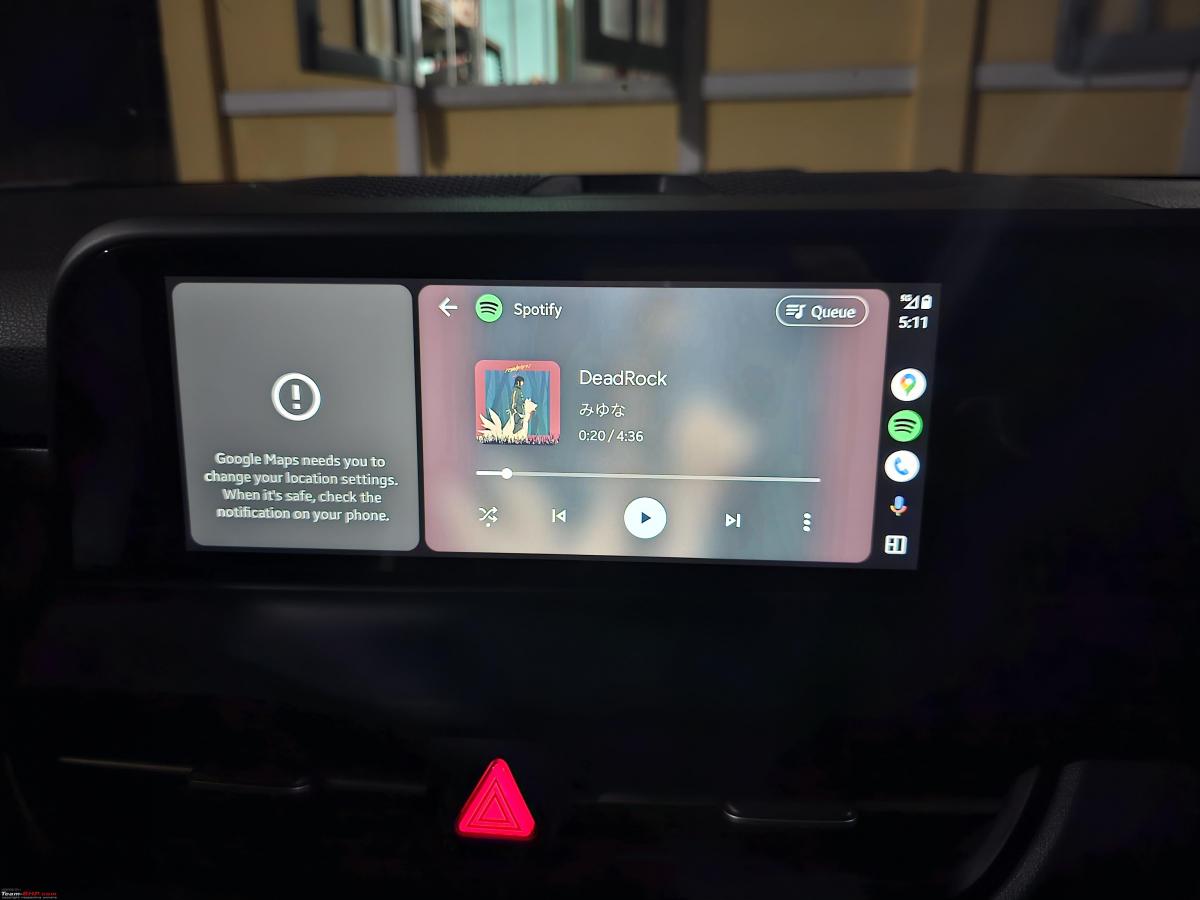
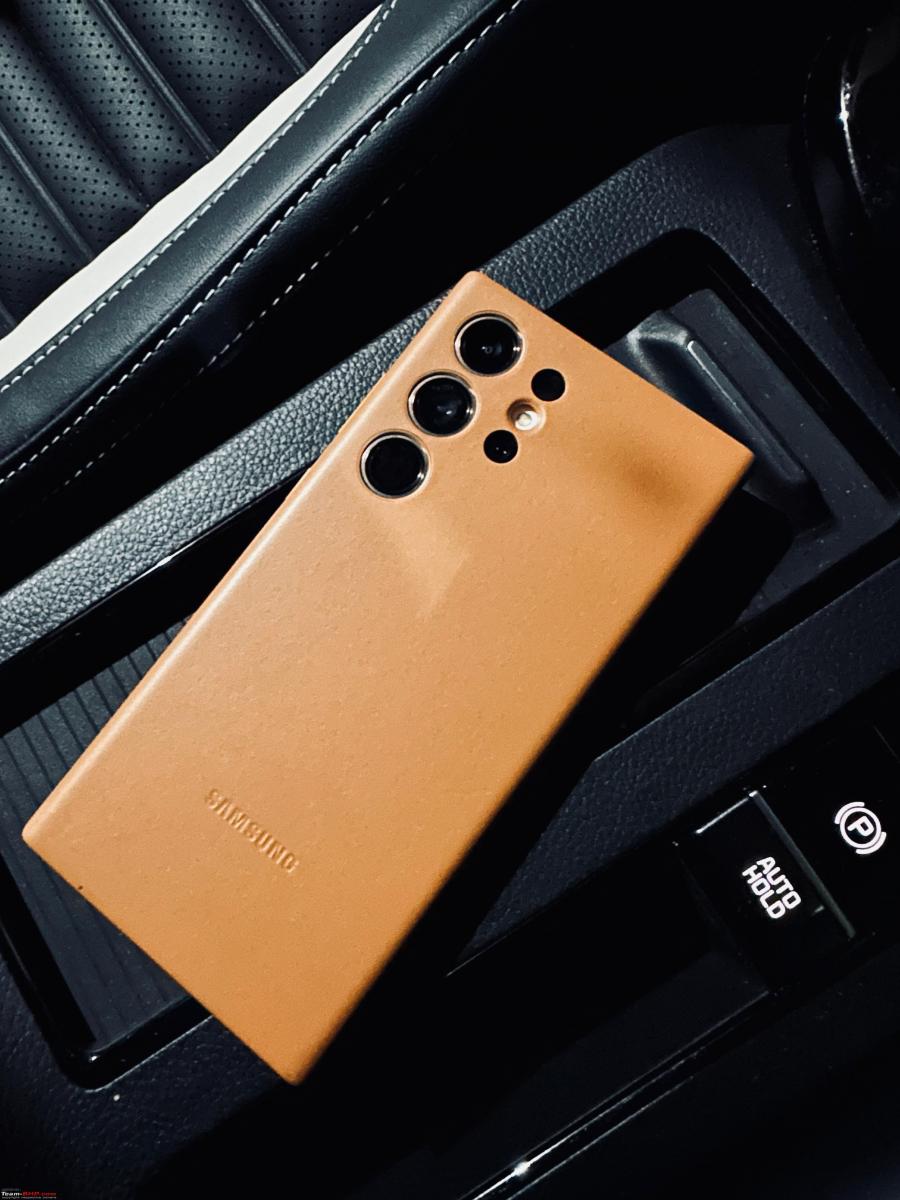
Check out BHPian comments for more insights and information.
- Tags:
- Indian
- Kia Selros
- Mahindra XUV700
News
Upgraded from a Kia Seltos to the 2023 Audi Q3: Initial impressions
The Technology variant was at a premium of 6-7L which we felt was not worth the price and hence decided to go with the Premium Plus variant.
BHPian aditya9567 recently shared this with other enthusiasts.
Intro
We recently purchased a new Audi Q3 after a few months of deliberation and research. I thought I’d post a short review of our experience and the car to aid anyone thinking of purchasing a car in the segment. Given that the official review is comprehensive, I am going to limit this review to my observations and aspects specific to the Premium Plus variant for the sake of brevity with my general laziness not playing any part in the decision.
Likes
- Audi’s Physical Health and Back to Basics package exclusive to the Premium Plus variant that I will detail out later. The Physical Health Limited package is applicable to the Indian Q3 in general, again detailed out later.
- A lovely price tag because who doesn’t like to see big numbers on a cheque.
- Special “Bring Back to Ground” feature through some interior plastic quality that gains more power the lower you go in the interior. The feature works in conjunction with the price tag and is designed to keep you close to Earth just in case you start to fly high after buying a luxury car.
- The powertrain helps form a brotherhood with owners of multiple cars below and above the segment.
- Provides continued ambition to earn and perform better in life to keep up with the expected maintenance costs.
Dislikes
- Driving experience - the 2L TFSI engine is too quick for Indian roads. Gentle dabs of the throttle increases speed faster than you can say “Oh no”, very dangerous.
- The sorted dynamics of the car add to the frustration as you reach the next jam or the next traffic light sooner.
- The gearbox needs a special mention as the car is most likely going to go through 2 of them but more so because of its disturbing ability to read your right foot better than a palmist can read your right hand.
- Solid build quality throughout that makes you feel you worked out more while closing doors or the boot. The car doesn’t give rattles (not yet at least) to enhance your hearing and scouting ability.
- On a scale of Alfa to Porsche, the car probably scores a BMW on build quality.
- Noise insulation and the refined experience makes you feel disconnected from the lovely music on our roads.
- Discontent from one of the leading professionals in the auto industry because of all the unnecessary extra safety equipment when we all know 4 doors is enough to protect individuals from outside harm.
Background
The new car replaces a 2020 Kia Seltos. While in the past, we have kept cars for a long time, the Seltos was sold after a short period on concerns of safety. We probably would not have bought the Seltos initially if the GNCAP ratings were out then but better late than never.
Primary requirements from the car are a medium sized crossover offering a good driving experience and premium interiors. An important factor was also the size and the turning radius for ease of maneuverability. The usage is around 15-20k km a year roughly split 60:40 city to highway. The car is primarily used by my parents.
A serious search for a new car began when the Tiguan was updated in June with refreshed interiors. The continually increasing prices were another factor that hastened our decision.
Alternatives considered
VW Tiguan: The Tiguan was perfect on paper – premium crossover, practical, loaded with features, excellent powertrain and dynamics. The driving experience was pretty good, very similar to the Q3 but the interior quality and the design did not feel up to the mark. The SA was also interested in selling the Taigun more than the Tiguan.
Skoda Kodiaq: Excellent interiors with different materials, pleasing design and loaded with useful features. The only fly in the ointment was the size and the large turning radius. If the Kodiaq’s interiors were on the Tiguan, we would have probably gone for that.
Hyundai Tucson: The Tucson was a big surprise. The interior quality and design felt very modern and well put together. The car feels very spacious inside, thanks in part to the gray interior colour. The powertrain, however, is not as good as the VAG cars. The petrol is uninspiring while the diesel is punchy but has a bit of a lag. Transmission isn’t as well tuned either. It is a practical crossover and would have been more of a head purchase rather than a heart purchase.
Volvo XC 40: Ever since the XC 40 came out a few years ago, I have loved the design direction the company has taken from the V40 to their sedan series. The cabin was well put together and the car was properly modern compared to its German rivals offering the latest tech (ignoring their real world applications in India). The engine felt sprightly but boomy inside. Upshifts and downshifts took a tad longer than the Audi dual clutch. The biggest gripe is with the back seats, they are upright and have low thigh support. The rear seats do not have any adjustments. My guess is that Volvo designed the car to be both a petrol and EV variant and they had to make certain compromises to fit the battery pack under the seats.
Ioniq 5: The major reason for considering this car was the price and the running costs. The Ioniq 5, due to the road tax exemption, offered more car per rupee. We could have probably overlooked the nascent charging infrastructure but it ultimately did not feel like a crossover which was an important requirement.
Mercedes GLA and BMW X1: The new GLA significantly improves on the practicality and interior space from the previous gen but still did not feel sufficient. More importantly, the cost was the deciding factor with MB not offering any discounts. We would have to go for the diesel costing around 62L on road Bangalore (the petrol option is not worth the price IMO), which would have stretched the budget considerably. The X1 was rejected due to the powertrain options.
Booking and delivery experience
Once we narrowed down to the Q3 and initiated serious discussions, we found the SA to be highly amenable to negotiation. After a few rounds, the list price and the actual offered price were poles apart. The SA also offered around 10% further discount on an MY23 CBU that they had received earlier in the year. The CBU missed out on dynamic indicators compared to the CKD. The CBU was a no brainer, in my opinion at least. The Technology variant was at a premium of 6-7L which we felt was not worth the price and hence decided to go with the Premium Plus variant. Audi also sells a Premium variant, on order, but its even more watered down with fabric seats, halogen indicators and rear lights.
The deal included a 3 year comprehensive service pack and 3 years extended warranty (5 year warranty in total). We were allowed to do a PDI at the showroom after which the booking amount was paid. The car had 44km on the odo during the PDI. Other formalities were done soon after.
Pictures during the PDI.


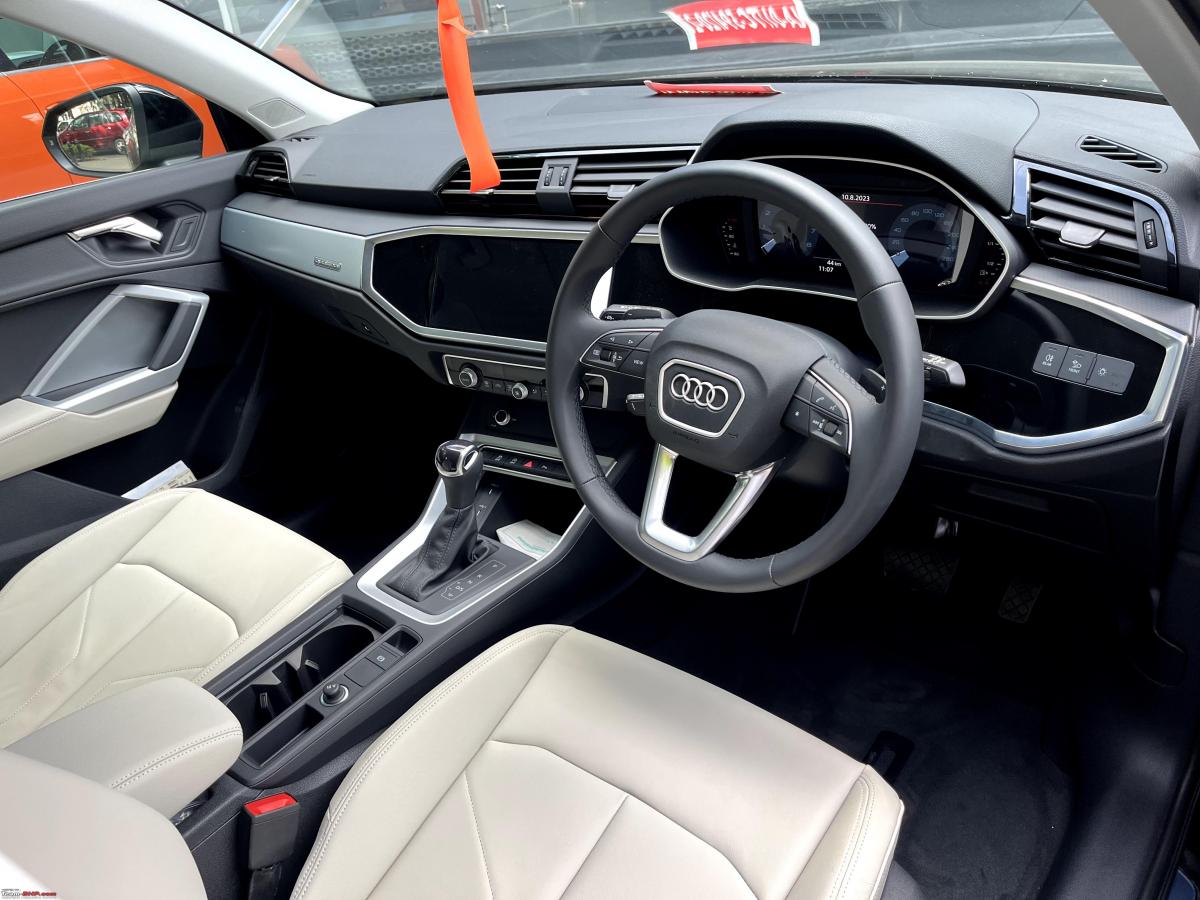
The delivery experience was standard fare, with a cake cutting, an unveiling and handing over of the key. What was surprising was the Rs 10k in freebies that we received which included 5k in fuel as the car was 80-90% filled up.

The remaining 5k is largely notional from this Audi branded pot. I know the plant probably doesn’t cost that much, but the pot is premium as it is widely accepted that slapping a premium badge on everyday objects like water bottles, ties, caps etc. increases its value by atleast 20x.
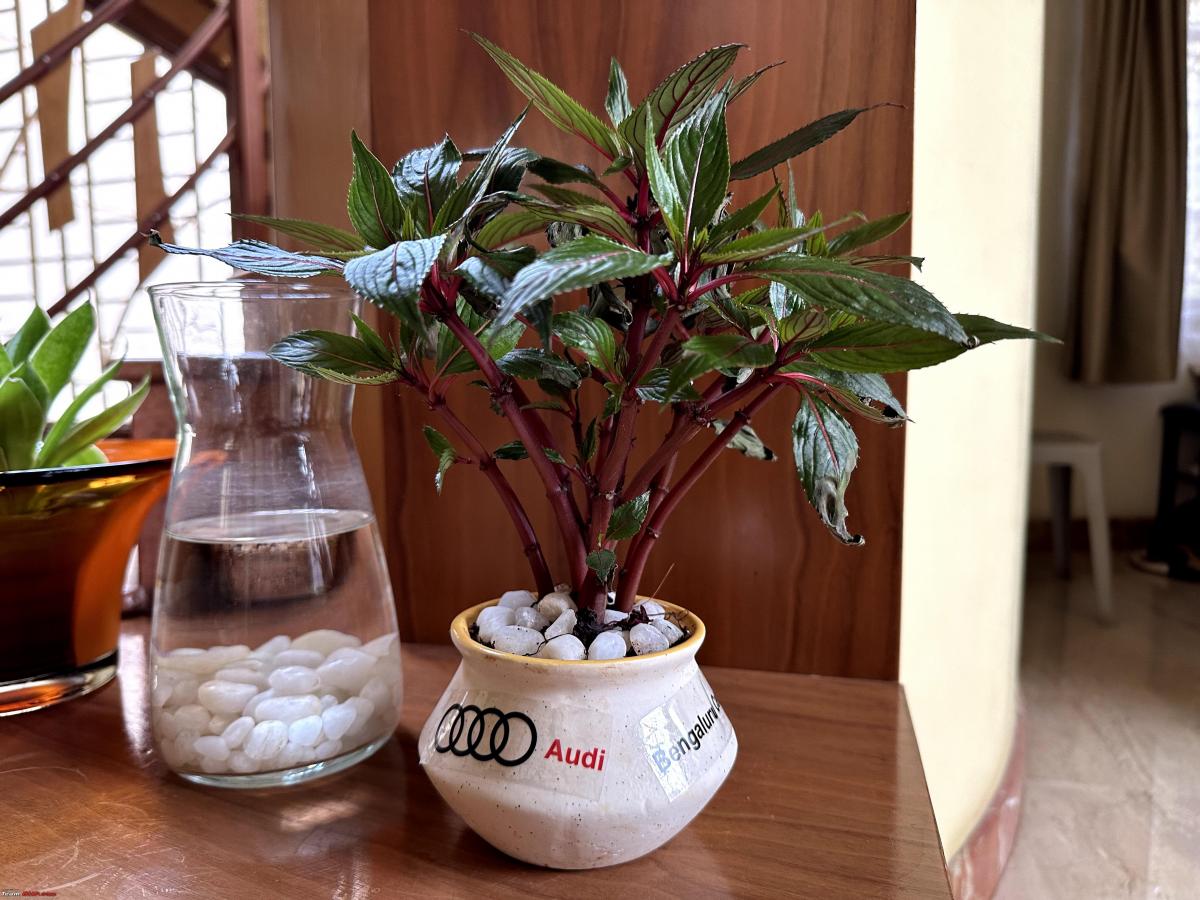
It was a smooth experience throughout. The SA was fairly new and was not 100% adept with the car and brand’s specifics but was very responsive and good to deal with.
Exterior
I’ve always liked how the Q3 looks. The new generation modernizes the car while retaining the design aesthetic. The newer gen features cleaner lines compared to the curvy design of the older gen. It is, however, instantly recognizable as a Q3.
There is no visual difference from the outside between the PP and the Technology variant. The official review covers this in detail, so I will limit myself to a few shots.
Handsome front face with the Audi family hexagonal grille.

A nice side profile with a sloping roof design towards the latter half of the car. The silhouette is not as raked as the Sportback but is instantly noticeable when compared to something like the Seltos which has more of a boxy shape. While the rear headroom is not compromised, the feeling of space in the boot is reduced. The alloy design is fairly bland, the international version gets much better looking wheels.

The rear 3/4ths shot highlights the SUV/crossover look that the car is going for.

Pleasing rear design. Distinctive LED tail lights look great. The fake dual exhausts give cars a real performance vibe said, no one ever. I could’ve done without them to be honest.
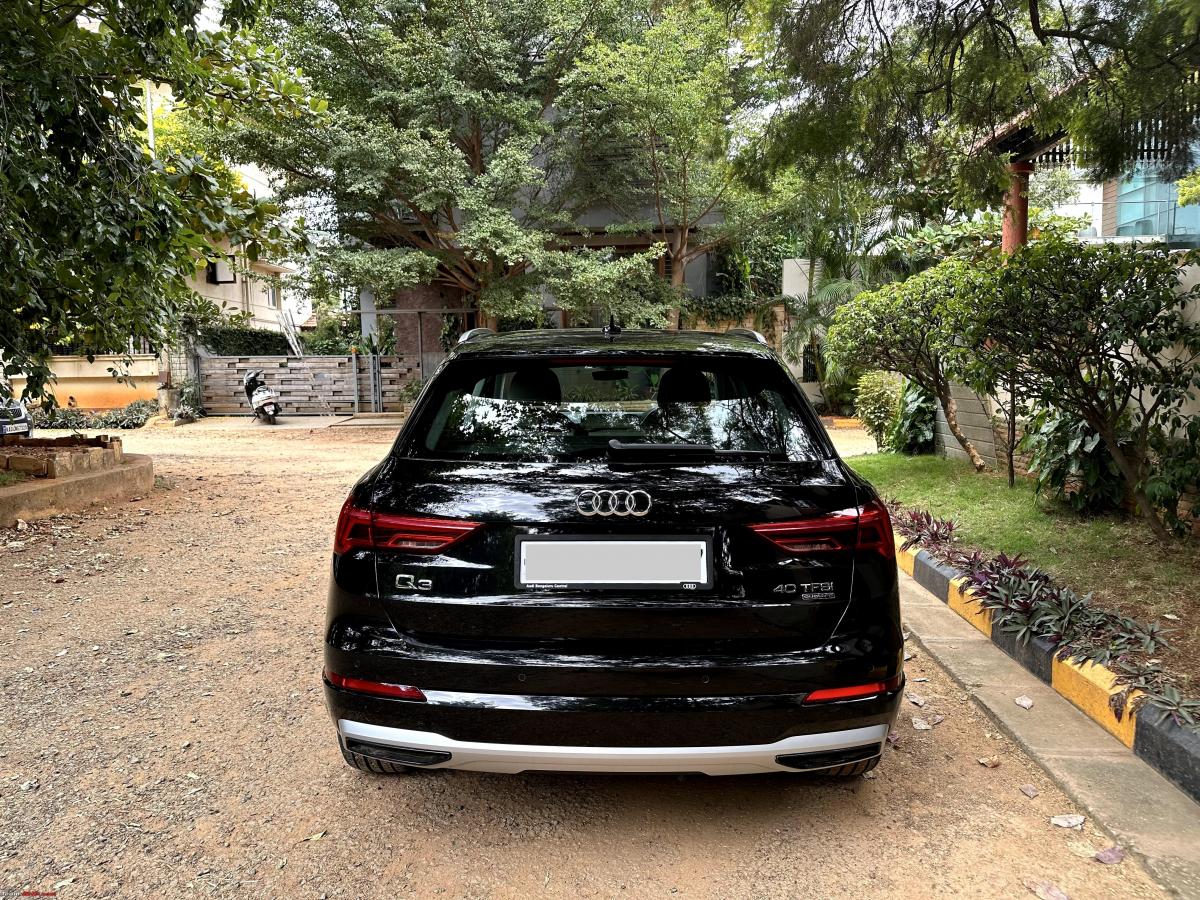
Interior
The interior has a nice look. I quite like Audi designs with its clean understated lines and relative minimalism. I believe that this will age better than something like the Tucson’s design. Overall interior quality is on par with soft touch materials on the dash but harder plastics lower down.
I have observed that newer generations of cars have lower quality materials in general across manufacturers. Materials used in this Q3 do not feel as premium as the previous gen.
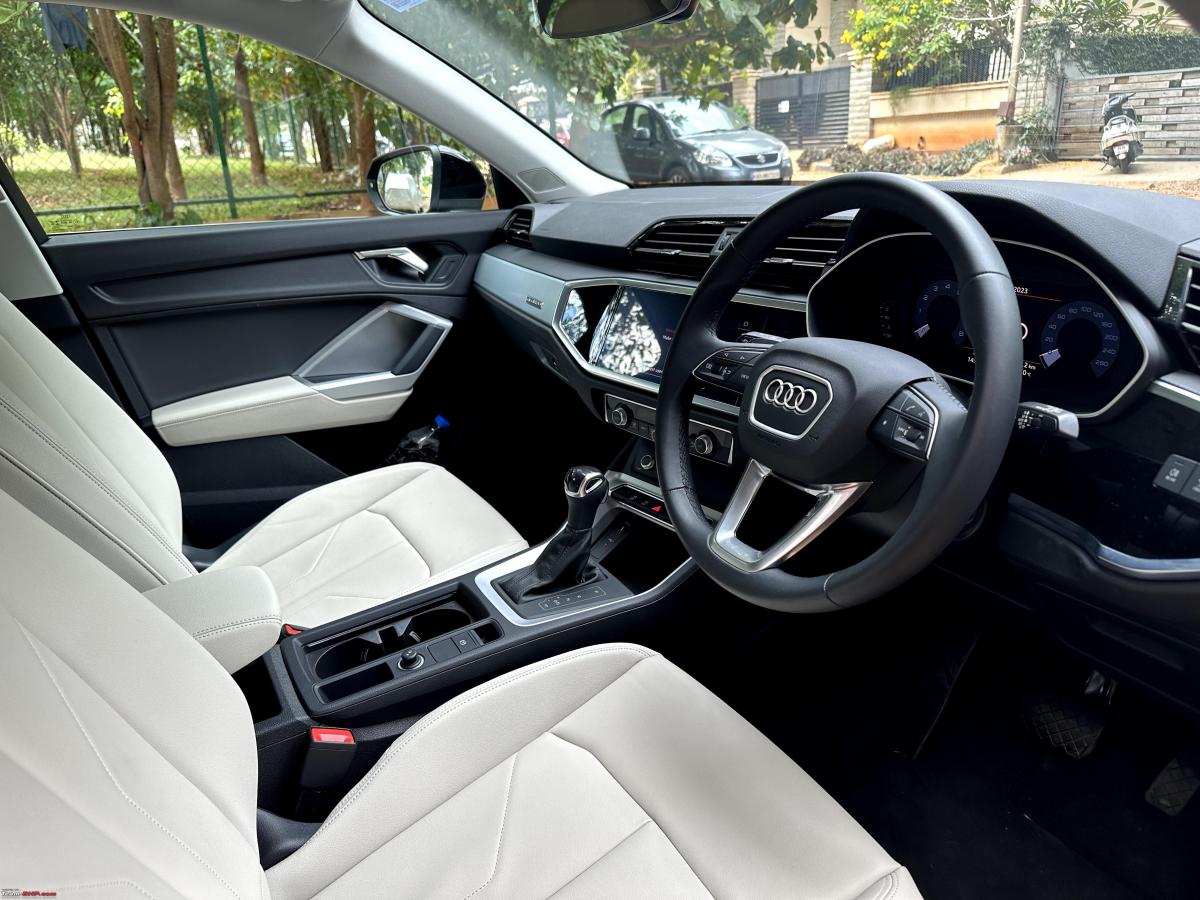
The beige colour seats lift the ambiance aided by the panoramic sunroof. Both front and rear seats are comfortable with adequate thigh support. The front seats also provide lumbar support which is welcome.
Overall practicality is good with sufficient leg room in the back thanks to the increased wheelbase over the previous gen. The boot capacity of 530 litres should also cater to most of our needs.
The cockpit is tilted towards the driver to provide easy access to the infotainment screen. The ergonomics are spot on with all controls falling easily to hand.
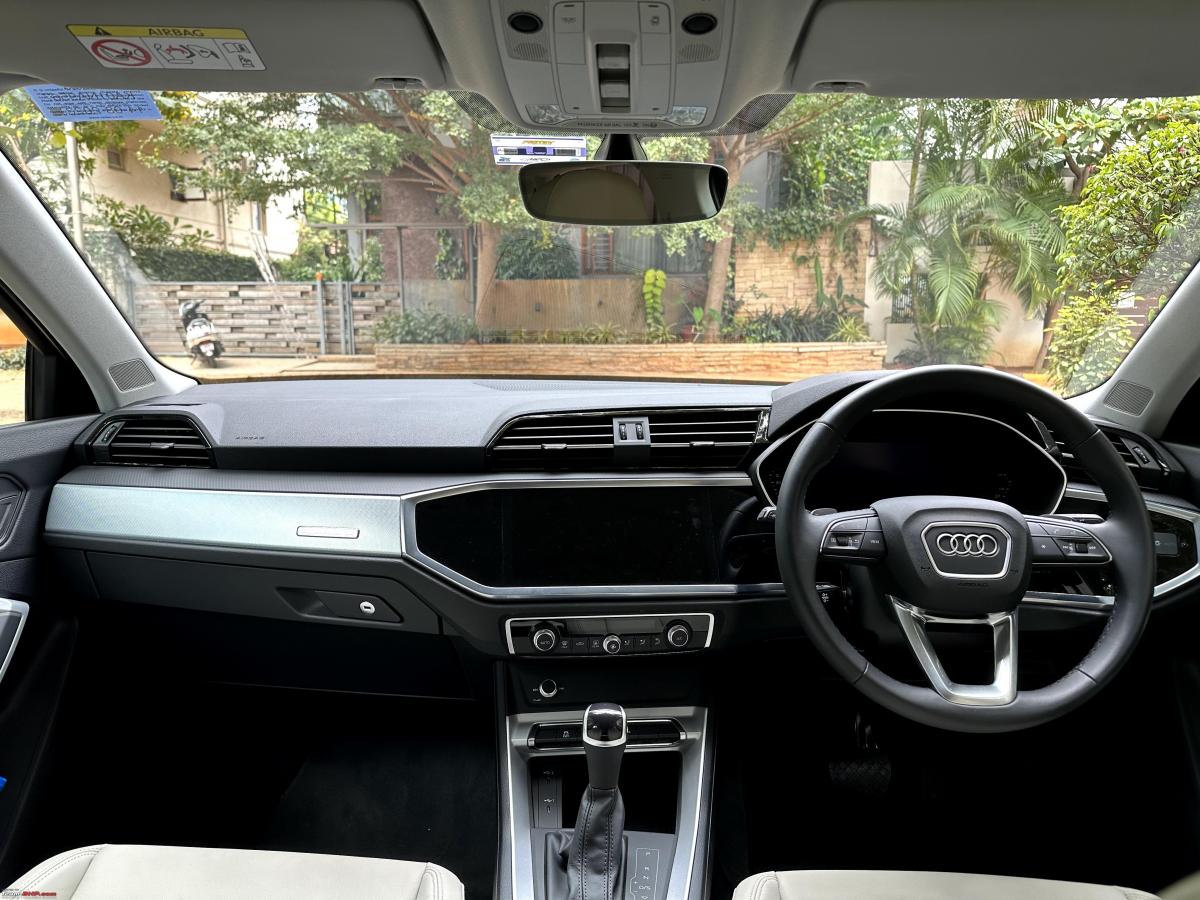
This portion of the dash looks even more plain without the start stop button. Thankfully it retains buttons and knobs to control essential functions. The switchgear feels tactile and premium.
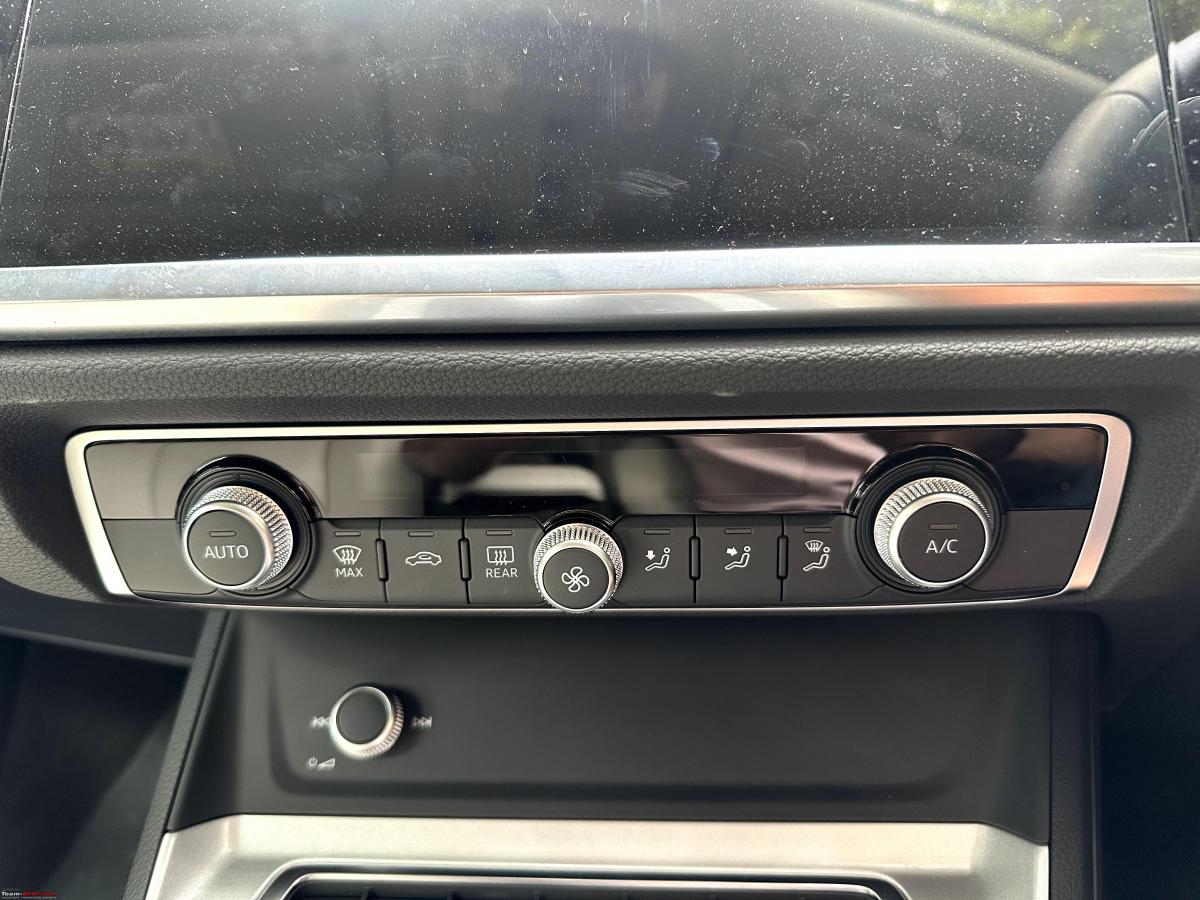
Well designed centre console. The cupholders have ambient light strips which look good at night.

A unique way to switch on the interior lights – just touch them. A clever feature that is frequently missed is the ability to change the intensity of the lights which can be done by continuing to touch the light till the desired intensity is reached. This works on the rear cabin lights as well.

The interior is where the majority of the difference is between the trim levels. On the face of it, it appears as though the Premium Plus misses essential features but dig deeper and you’ll find that Audi’s Physical Fitness and Back to Basics Pack actually provide more value in the long run.
- Wrist exercise through the usage of old school insert and turn key to start the vehicle. This is well complemented by the lack of any lights around the key ring to hone your night time vision.
- No electric tailgate - opening and closing it trains the lat muscles.
- Phone cooling feature – there’s no dedicated cooling provided but the phone is artificially cooled through the lack of wireless charging.
- Audi has figured out the right way to spell aluminium / aluminum which is to completely eliminate the requirement of the word by removing trims from the interior. Can’t spell a word wrong if you don’t have to use it.
- Single colour ambient lighting – Colour can distract people while driving and hence only white is provided.
- The quattro badge doesn’t light up like in the Technology variant. This is a subliminal message reinforcing that it is a passive AWD and the car cannot be taken everywhere.
- Inbuilt navigation is skipped because well, who uses it anyway.
- The digital screen has fixed dials to remind you of the golden age with only the center portion changing as per requirement.
- Audi acknowledges that drive modes in normal cars barely make any difference between modes by removing them altogether.
Continue reading BHPian aditya9567's review of his 2023 Q3 for more insights and information.
- Tags:
- Indian
- 2022 Audi Q3
- Kia Selros
News
Budget Rs. 15-20 lakh: Buying my first car
While the Seltos ticks all the boxes for me, it's safety report and record makes it a questionable choice.
BHPian KadiNiSikhiya recently shared this with other enthusiasts.
Hi,
I'm looking to buy my first car in January 2022(cannot wait beyond this as my wedding is in February). The last car we bought was back in 2005, a Maruti Esteem VXi. For the upcoming buy, my requirements are as below:
- Budget: Rs. 15 lakh(easy)-20 lakh(Hard).
- Range: 100Km+ whenever driven, as it's not going to be a daily driver but rather family mover(3-4 people) over long distances for vacation/pilgrimage.
- Fuel: Owing to general wisdom that petrol engines are low maintenance w.r.t diesel ones and the lower cost of petrol variants, I'm inclined towards Petrol.
- Mileage vs Performance: Whenever it will be driven, it would be on longer routes and sometimes on poor roads, I opt for performance.
- Comfort vs Carriage: As my parents are both 60+, I want something that has good 2nd row features and comfort. But as long-distance travel requires some luggage, that some is summed up in our household, so need a good amount of boot space too.
Now here's what I have evaluated. All sub 10 lakh SUVs (XUV300, Sonet, Venue, Brezza, Nexon) are small when it comes to luggage carrying capacity.
In 10-15 range, I'm considering mainly Seltos HTX G. Creta is ugly for my taste, Taigun and Kushaq aren't "feature rich" plus costly service and spares for them. Don't like MG Astor either. Scorpio, my mother doesn't like it.
While the Seltos ticks all the boxes for me, it's safety report and record makes it a questionable choice. Now inching above the 15 lakh bracket puts a strain on my budget but I get the option of XUV 700. Not considering Hector or Harrier here.
In case of 700, as per the review thread here, diesel makes more sense and that too 7 seater version and it will come in useful if in case the in-laws too join us for a trip. But the basic AX3 7 seater misses out on key features of safety and comfort and while AX5 has curtain airbags, it misses out on Cruise Control and also its on-road price is just shy of 20 lakh, a costly proposition considering what it doesn't offers.
Here's what BHPian Sushil Pingua had to say on the matter:
Hello Brother KadiNiSikhiya,
The Maruti S-Cross hits your requirements bang on. Has the best build quality among all Maruti models currently on sale.Easy on budget with the top model which is feature laden.
Comfortable over long distances for the rear passengers as well.
Very easy to get in or out for the aged parents.
Performance and boot space are balanced for a 5 seater. Frankly speaking if considerable boot space is required then a 6/7 seater vehicle with last row folded down does the job like my Honda BRV which is a 6 seater but we always travel max 4 people and fold the last seat row to use it as additional boot space - it amounts to truck-load space.
Enjoy.
Here's what BHPian TorqueMonster had to say on the matter:
If you are not keen on an SUV, why not go for the Honda City. It will easily seat 4 people comfortably, has a really competent petrol engine and for 40k more than your budget, you can get the top end ZX model for 15.4l. If the budget doesn't permit, you can always get the VX model too, which is also well equipped. And since it is a sedan, Boot space is aplenty in it. If you are not wanting SUV's this ticks your bill perfectly.
And as for SUVs, the Seltos is feature-rich but safety is an issue, while other cars don't seem to be your priority. You always have the S-Cross as the backup choice, even though I personally feel the car to be slightly dated wrt competition, it is still a good car.
Here's what BHPian lamborghini had to say on the matter:
Have a look at the S Cross. Specs on paper aren't great, and it doesn't have the butch SUV look like the seltos, neither is it feature rich.
But for the asking price you get a sturdy, abuse friendly, comfortable, well driving car. Effectively its in sub-4M category in terms of price despite being a segment higher. I expect the next gen S Cross to take the pricing closer to seltos / creta levels (as previous generation S Cross was priced similarly to previous generation Creta).
The Seltos is a good all rounder but for safety as you rightly pointed out. Plus Hyundai / Kia aren't niggle free either as some threads on here would elaborate.If you can deal with lower kit, but better handling, performance, safety, etc., have a look again at the Kushaq. With Skoda's 6 year warranty, maintenance would be lower as well. I wouldn't say Skoda spares are more expensive than Kia either as both are equally premium brands.
XUV700 has a long waiting period so getting one before your wedding may be difficult though it is a great all rounder on paper.
Check out BHPian comments for more insights and information.



